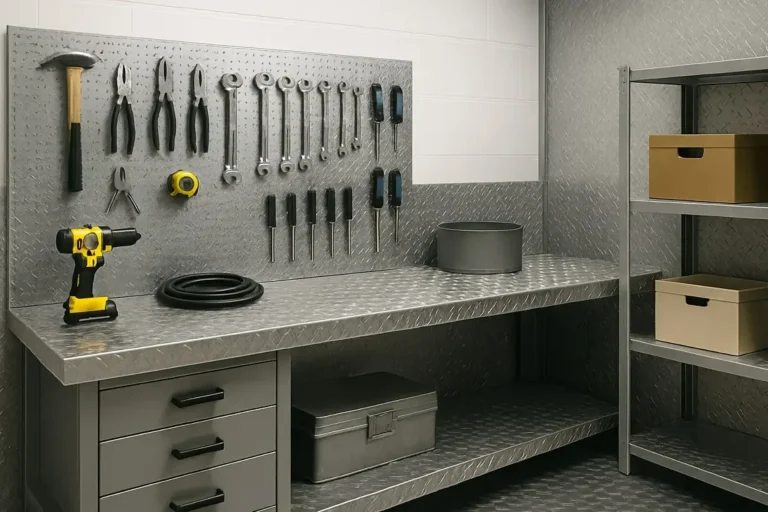A home workshop can be one of the most useful places in the house. Whether it’s for fixing things, working on projects, or just storing tools, it’s meant to handle real use. But the more it’s used, the more wear and tear shows up—scratched walls, dented bench edges, and floors that collect oil and dirt.
Making a workshop last isn’t just about cleaning or organizing. It’s also about using materials that can take a hit and still look good after years of use. One of the best ways to upgrade your space without rebuilding everything is to strengthen the parts that get used the most.
A Small Material Change That Does a Lot
Some materials break down quickly when they’re used over and over. Painted wood chips, plastic warps, and plain metal gets dented fast. That’s why so many people choose to buy aluminium chequer plate for their work surfaces, wall panels, and tool zones. It gives a clean look, protects against damage, and keeps its shape—even after constant use.
The raised pattern helps stop slipping, especially in spaces that get dusty or wet. And since aluminium doesn’t rust, it works well in cold garages, garden sheds, or anywhere that’s not perfectly dry. It’s light, easy to install, and doesn’t need much care beyond an occasional wipe down.
Workbenches That Hold Up Over Time
The bench is usually the most-used surface in any workshop. It’s where tools get dropped, parts get clamped, and projects get built. Most wooden workbenches look great when new, but they start to break down after a while. Edges chip. The top gets stained or uneven. It’s hard to work on a surface that doesn’t stay flat.
Covering the top with aluminium chequer plate is a smart fix. It adds strength, grip, and a surface that’s easy to clean. If something spills, it won’t soak in. If something heavy lands on it, it won’t crack. It also stops dents from spreading through the bench underneath.
For anyone starting fresh, aluminium plate can be used as the top layer right from the start. But it works just as well added on top of an older bench that needs new life.
Tool Walls That Stay Strong
Pegboards and tool racks make it easy to keep things organized—but they’re not always built for heavy tools. Over time, hooks loosen, boards sag, and some areas wear down from being used the same way every day.
Adding a backing made from aluminium chequer plate helps with that. It gives a solid base that won’t bend or splinter, even when tools are moved around a lot. It also adds a cool, finished look to the space. Some people even use offcuts of chequer plate to make custom tool holders or shelves.
Because the plate can be cut to size, it fits well into small corners or around outlets. It turns a basic wall setup into something that feels built to last.
Storage That Doesn’t Sag
Drawers, cabinets, and shelving units in home workshops are often made from thin board or plastic. That works fine for light items, but not so much for heavy gear or containers. The base can sag, and the corners sometimes split from the pressure.
Using chequer plate for the bottoms or sides of shelves adds extra strength. It also keeps sharp edges or dirty items from scraping the inside of drawers. Whether it’s for toolboxes, rolling carts, or fixed storage, it’s a quick upgrade that makes a big difference.
Floors That Can Take a Beating
Even though it’s not the first thing people think about, workshop floors go through a lot. Shoes bring in dirt. Tools fall. Spills happen. Some spots start to wear out more than others, especially near benches, doors, or under machines.
Instead of replacing the whole floor, aluminium chequer plate can be added to those high-use areas. It protects the surface underneath and stops slippery spots from forming. It’s also easy to hose down or sweep clean.
In small workshops, even one or two sheets placed in the right spots can help keep the floor in good shape longer.
How to Install It Without Overcomplicating Things
One of the best parts about working with aluminium chequer plate is how simple it is. You don’t need special tools. A jigsaw, drill, and some screws usually do the job. It can be cut to fit your bench, wall, or floor and secured with short fixings or adhesive.
Some people add rubber edging or corner protectors to finish it off, especially on surfaces they’ll lean on a lot. Others just smooth down the sharp edges with sandpaper or a metal file.
Either way, once it’s in place, it doesn’t need much attention. Just wipe it down when it gets dusty or oily, and it stays looking clean.
The Kind of Upgrade You Only Need to Do Once
Most DIY fixes need to be redone every few years. Paint chips. Boards wear out. Plastic cracks. But aluminium chequer plate doesn’t have that problem. Once it’s in place, it holds up. That’s why it’s used in trucks, stairs, toolboxes, and everywhere else that takes a lot of wear.
In a home workshop, that kind of reliability makes a huge difference. It means less time fixing the space and more time using it. Whether the goal is better looks, easier cleaning, or just something that won’t fall apart, chequer plate delivers.
A Better Workshop Without a Full Rebuild
You don’t need to knock down walls or replace everything to make a home workshop better. Just changing the materials in the most-used spots can make the whole space feel newer, stronger, and easier to use.
Aluminium chequer plate adds protection where it matters—on the bench, on the wall, under shelves, or at your feet. It’s easy to install, simple to clean, and built to last. For anyone tired of constant repairs or worn-out surfaces, it’s one of the smartest upgrades you can make.

